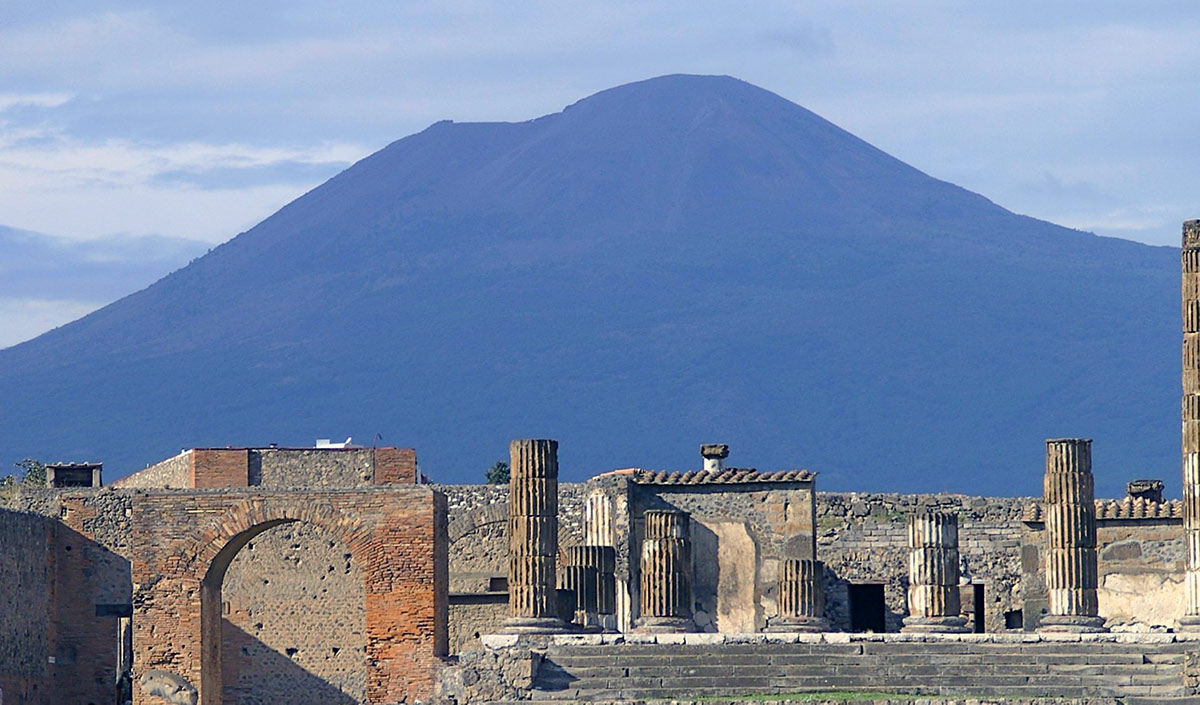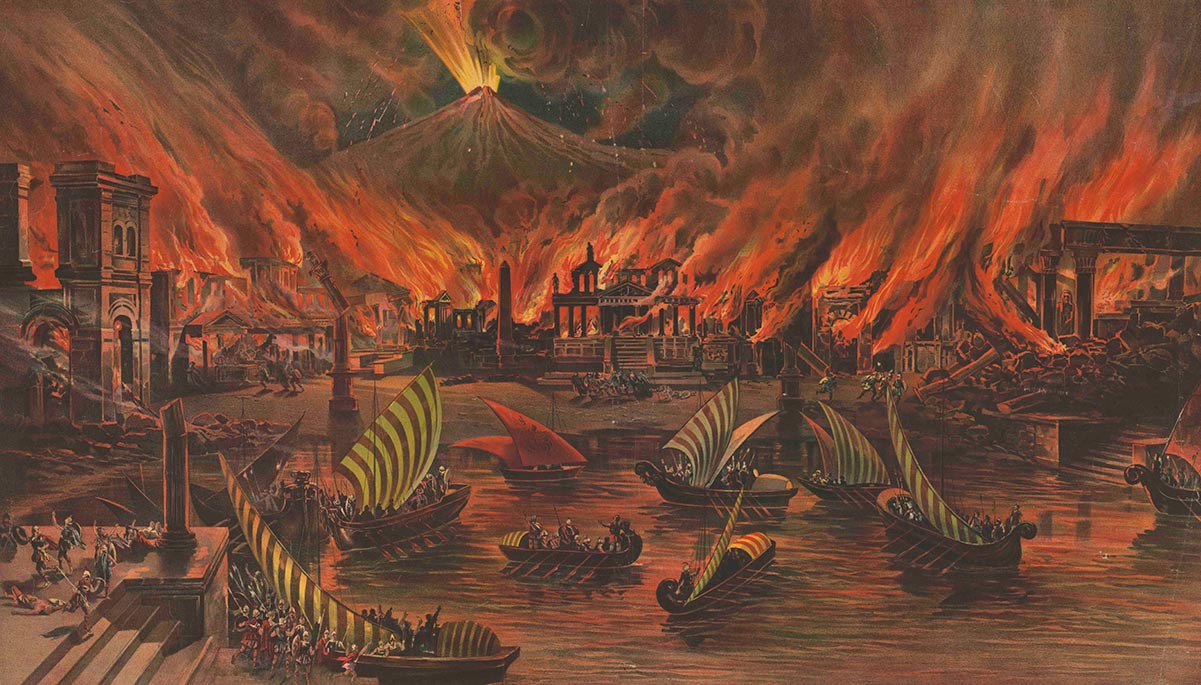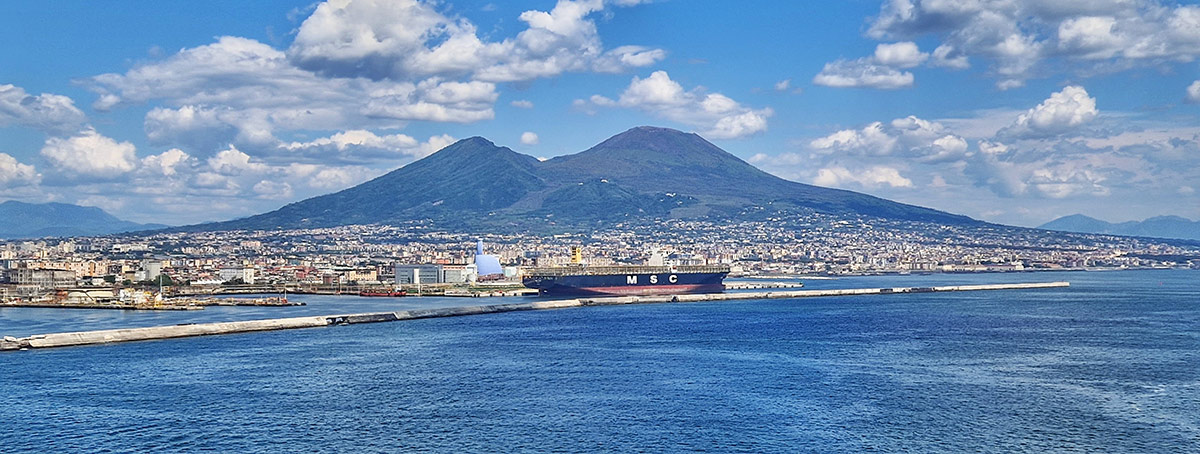It is one of the most infamous volcanic eruptions in history. On 24 August 79 AD, Mount Vesuvius erupted causing devastation to the surrounding area. Entire towns including Herculaneum and Pompeii were obliterated and buried underneath massive pyroclastic surges and ashfall. Thousands of people were killed. Pompeii was not rediscovered until the 16th century.

The city of Pompeii was located on the coast of what is modern day Italy about 24 km (15 miles) south of Naples. It was a major trading centre and popular resort town for wealthy Romans.
The Oscans were the first settlers on the site in the 8th century BC. The Greeks arrived in Campania from around 740 BC and Pompeii fell under their influence. It became a safe port for both Greek and Phoenician sailors at this time and the city began to flourish as a result of the maritime trade.

By 524 BC, the Etruscans controlled the area and allied it with other nearby cities. It was they who built the forum and Temple of Apollo. In the following years, Pompeii was captured by the Greek city of Cumae and began to decline. Parts of the city were abandoned from about 450 BC as it became less important as a trading centre.
The Samnites arrived in the area around 375 BC and Pompeii enjoyed a resurgence. They were followed by the Romans between 343 BC and 340 BC and the city began another period of expansion.

Pompeii was not officially part of the Roman Empire in this period but was closely aligned with them. Lucius Mummius granted the city a statue of Apollo In the 2nd century BC to recognise their support in the sack of Corinth. Pompeii became very wealthy at this time and a new Forum and many public and private buildings of high architectural quality were built including The Large Theatre, the Basilica, the Temple of Jupiter, the Stabian Baths and more.

A rebellion in 89 BC led to Lucius Cornelius Sulla Felix besieging the city and as a result, Pompeii became a Roman colony named Colonia Cornelia Veneria Pompeianorum. The people of the city became Roman citizens and Latin became the main language.
Pompeii became a popular location for wealthy Romans due to its location on the Bay of Naples. The area was surrounded by rich agricultural land and farms and villas were built nearby. The city became increasingly prosperous during this time as its importance as a trading hub increased. Over the next 100 years or so, Pompeii was expanded with many fine public buildings being built.

On the 5 February 62 AD, Pompeii was rocked by a severe earthquake and much damage was caused throughout the city. The philosopher and dramatist Seneca the Younger wrote an account of the earthquake and reported that the shaking continued for days. He theorised that earthquakes happened as a result of the movement of air. Damage was caused from Naples to Nuceria and the nearby town of Herculaneum saw extensive devastation. This was a precursor of what was to follow.
Pompeii began to rebuild after the earthquake with public officials seizing the opportunity to make improvements to the layout of the city. Some of the buildings that were destroyed were cleared to make way for the new Central Baths. Emperor Nero and his wife Poppaea visited in 64 AD to see how the reconstruction was progressing. By 79 AD, the population of Pompeii was 20,000.

In mid-August of 79 AD, a number of minor earthquakes shook Pompeii. They were not particularly strong and as Campania, the area in which the city is located, is prone to seismic activity, little was thought of it. The residents had no idea what was to come.
At 1pm on 24 August 79 AD, Mount Vesuvius erupted violently ejecting lava, pulverised pumice and ash into the air. Columns of hot gases and ash reached the stratosphere. The thermal energy released was 100,000 times that of the atomic bombings of Hiroshima and Nagasaki.

The eruption of Mount Vesuvius was sudden and unexpected. The people of Pompeii had no warning and were caught unprepared. Many were killed instantly by the falling ash and rock. Others died from suffocation as the ash filled the air. Some died from heat and toxic gases. The eruption lasted for two days and it buried Pompeii under a layer of ash that was up to 6 metres (20 feet) deep.
The pyroclastic flows from the eruption moved fast, destroying or covering everything in their path. The remaining population of Pompeii was incinerated or suffocated as the intensely hot flows hit the city. Minor tremors accompanied the eruption and caused a tsunami in the Bay of Naples. The eruption left the landscape along the coastline altered. A haze from the ash and dust filled the air for many days.

The Emperor Titus arranged relief efforts for victims of the eruption and visited the area soon after the disaster. He gave money to help survivors although very little could be done for the city of Pompeii which was now buried beneath and the ash and deposits.

Thieves were able to salvage some of the precious material from the city including marble from the forum. In some cases, they dug tunnels to reach buried parts of the city. Pompeii gradually became forgotten, abandoned under the destruction and two further eruptions buried the city even further.
In 1549, an architect named Domenico Fontana was digging a canal through the area when he unearthed some ancient ruins. Some of the walls featured inscriptions and paintings but Fontana either didn’t realise the significance of his discovery or kept it secret so as not to stop the building of the aqueduct.
In 1738, during construction of a Summer palace for the King of Naples, Charles of Bourbon, ruins were discovered which were found to be those of Herculaneum. A Spanish military engineer named Roque Joaquín de Alcubierre was commissioned to excavate the site.

While excavating Herculaneum, Alcubierre heard rumours of ancient ruins in the nearby village of Torre Annunziata. He decided to investigate and soon discovered the ruins of a Roman amphitheatere. Alcubierre realised that he this was yet another lost city and he began to excavate the site. On 20 August 1763, an inscription reading “Rei Publicae Pompeianorum” (Republic of the Pompeians) was found and the city was identified as Pompeii.
The ruins of Pompeii have revealed a fascinating glimpse into Roman life. The city’s streets are still lined with shops and houses and its temples and baths are still standing. The ruins have also revealed a wealth of information about the everyday lives of the people who lived in Pompeii.

One of the most striking things about Pompeii is the way it has been preserved. The ash that buried the city acted as a protective layer, preventing the elements from damaging the ruins. As a result, the city has been remarkably well-preserved and it offers a rare glimpse into the past.

The ruins of Pompeii have also revealed a number of disturbing discoveries. The bodies of the people who were killed in the eruption were preserved in the ash and they have been found in a variety of poses. Some people were found clutching their loved ones, while others were found trying to flee the city.
The discovery of the bodies of the victims of the eruption of Mount Vesuvius has been a source of fascination and horror for centuries. It is a reminder of the power of nature and the fragility of human life.

The excavations at Pompeii continued for many years and the city was gradually revealed. Pompeii has become one of the most important archaeological sites in the world, and it provides a unique glimpse into life in ancient Rome.

